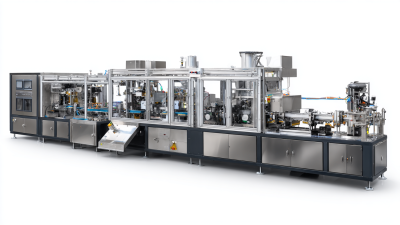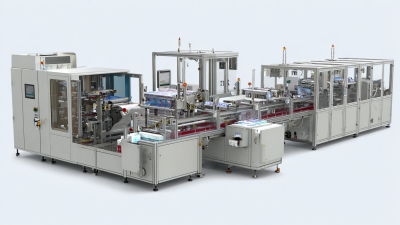Revolutionizing Packaging: How Pouch Filling Machines Enhance Efficiency and Sustainability in Modern Manufacturing
In the rapidly evolving landscape of modern manufacturing, efficiency and sustainability have become paramount concerns for businesses looking to thrive in a competitive market. One of the most significant advancements in packaging technology is the pouch filling machine, which has transformed the way products are packaged, stored, and transported. By automating the filling process, these machines not only streamline operations but also contribute to reducing waste and improving resource management, aligning with sustainability goals.
The adoption of pouch filling machines has proven to enhance productivity, allowing manufacturers to meet increasing consumer demands while minimizing labor costs. Their versatility enables the packaging of a wide array of products, from food and beverages to pharmaceuticals and personal care items. As industries shift toward more eco-friendly practices, pouch filling machines provide an opportunity for companies to reduce the carbon footprint associated with traditional packaging methods. By utilizing lightweight materials and optimizing production workflows, manufacturers can achieve both operational efficiency and sustainable practices.
In summary, pouch filling machines play a pivotal role in revolutionizing the packaging sector, bridging the gap between efficiency and sustainability. As the industry embraces these innovative solutions, businesses are poised to enhance their competitiveness while contributing positively to the environment, paving the way for a more sustainable future in manufacturing.

The Rise of Pouch Filling Machines in the Packaging Industry
The rise of pouch filling machines in the packaging industry is transforming traditional manufacturing processes, with an increasing number of companies adopting these advanced systems. According to a report by MarketsandMarkets, the global pouch packaging market is projected to reach $51.9 billion by 2025, growing at a CAGR of 4.8% from 2020. This surge reflects a growing preference for flexible packaging solutions, particularly in industries such as food and beverage, personal care, and pharmaceuticals, where pouch filling machines offer significant advantages in efficiency and sustainability.
One key factor driving this trend is the efficiency these machines provide. Pouch filling machines streamline production lines by automating the filling and sealing processes, which can dramatically reduce labor costs and turnaround times. A study by Research and Markets highlights that automated pouch filling systems can improve production speeds by up to 30% compared to traditional methods. Additionally, these machines are designed to minimize material waste; many are equipped with precision filling technology that reduces overfilling, making them more environmentally friendly. This alignment with sustainability goals is crucial as companies strive to meet rising consumer demand for eco-conscious packaging solutions.
Efficiency and Sustainability in Pouch Filling Machines
This chart illustrates the relationship between efficiency and sustainability metrics in modern pouch filling machines. As companies adopt these machines, we can see significant improvements in both areas, showcasing the advantage of pouch filling technology in the packaging industry.
Efficiency Gains: How Modern Machines Reduce Production Time by 30%
The innovation of pouch filling machines significantly boosts efficiency in modern manufacturing, contributing to a remarkable 30% reduction in production time. These advanced machines streamline the packaging process, minimizing manual intervention and enhancing operational speed. By automating tasks such as filling, sealing, and packaging, manufacturers can significantly accelerate their production lines, allowing them to meet increasing demands without compromising quality.
Furthermore, the integration of these machines aligns with sustainable practices in manufacturing. With improved technology, pouch filling machines utilize less material and energy, thereby reducing waste and lowering the environmental impact. As companies increasingly prioritize sustainability, the ability to enhance production efficiency while minimizing ecological footprints makes pouch filling machines a vital component of modern manufacturing strategy. The synergy between efficiency gains and sustainability not only meets market demands but also positions manufacturers to thrive in a competitive landscape.
Environmental Impact: Pouch Packaging's Role in Waste Reduction
Pouch packaging is becoming a crucial player in the quest for sustainability, particularly in industries like coffee. As a response to growing concerns regarding packaging waste, many roasters are now opting for recyclable, biodegradable, and compostable bags. This shift plays a vital role in fostering a circular economy, where materials are reused, recycled, or composted, ultimately minimizing waste. Recent reports indicate that packaging accounts for approximately 30% of total waste generated in Europe, highlighting the importance of adopting sustainable solutions. By investing in pouch filling machines, manufacturers can enhance production efficiency while simultaneously addressing environmental challenges.
Tips:
- Consider switching to pouches made from materials that can be recycled or composted, reducing the environmental impact of your packaging.
- Streamlining packaging design to eliminate unnecessary materials can further promote sustainability and decrease overall costs.
- Engage consumers in your sustainability efforts by providing information on how to properly dispose of or recycle their packaging.
Implementing these strategies not only benefits the environment but can also improve brand image and customer loyalty. In an era where consumers are increasingly eco-conscious, businesses that prioritize sustainable packaging solutions are likely to thrive in the competitive market.
Cost-Effectiveness: Analyzing ROI from Automated Filling Machines
The adoption of pouch filling machines in modern manufacturing not only enhances efficiency but also presents significant cost-effectiveness that warrants careful analysis of return on investment (ROI). Automated filling machines streamline production processes by reducing labor costs and minimizing the time required for packaging. By transitioning from manual filling methods to automation, companies can increase output without a proportional rise in operational expenses. This efficiency allows manufacturers to meet market demands more effectively while maintaining profitability.
Evaluating the ROI from the implementation of automated filling machines reveals long-term financial benefits. While the initial capital investment may appear substantial, the decrease in labor costs and the increased speed of production lead to rapid payback periods. Additionally, reducing waste associated with manual filling processes contributes to cost savings and improves sustainability. The ability to utilize smart technology in pouch filling also leads to enhanced precision, reducing product spoilage and ensuring consistent quality. Consequently, businesses can expect significant financial returns over time, making automated filling machines not just a wise operational choice, but a pivotal strategy in modern manufacturing.
Revolutionizing Packaging: How Pouch Filling Machines Enhance Efficiency and Sustainability in Modern Manufacturing - Cost-Effectiveness: Analyzing ROI from Automated Filling Machines
| Metric | Value | Notes |
|---|---|---|
| Initial Investment | $50,000 | Cost of a mid-range automated filling machine |
| Annual Operating Cost | $10,000 | Includes maintenance and utilities |
| Increase in Production Efficiency | 30% | Efficiency gained by automation |
| Time Saved per Day | 4 hours | Time previously spent on manual filling |
| Annual Revenue Increase | $120,000 | Projected based on increased output |
| Return on Investment (ROI) Percentage | 150% | Calculated based on profits over 3 years |
| Reduction in Material Waste | 20% | Improved accuracy leads to less waste |
| Employee Satisfaction Improvement | 15% | Less manual labor leads to happier staff |
Innovative Materials: Enhancing Sustainability with Eco-Friendly Pouches
The modern packaging industry is undergoing a significant transformation, with eco-friendly pouches at the forefront of this revolution. These innovative materials are not only designed to reduce environmental impact but also enhance the efficiency of manufacturing processes. By utilizing biodegradable and recyclable substances, companies can minimize waste and support a circular economy. The adoption of eco-friendly pouches aligns perfectly with consumer demand for sustainable practices, making it a win-win for both businesses and their customers.
Tips for selecting eco-friendly pouches:
- Look for certifications, such as biodegradable or compostable labels, which ensure that the materials meet specific environmental standards.
- Consider the source of the packaging materials; opting for suppliers that prioritize sustainable practices can significantly enhance your product's eco-credentials.
- Evaluate the pouch's versatility and durability to ensure it maintains product integrity while minimizing environmental impact.
As manufacturers increasingly adopt these sustainable packaging solutions, the blending of efficiency and environmental responsibility continues to pave the way for a greener future. In this context, the integration of pouch filling machines aids in streamlining production, ultimately reducing energy consumption and supporting a more sustainable supply chain. The shift towards innovative materials not only addresses pressing environmental concerns but also sets the stage for a new era in packaging that champions both efficiency and responsibility.
Related Posts
-

Innovative Pouching Machine Designs Transforming Packaging Solutions
-

Essential Food Packing Machine Checklist: 10 Key Factors for Optimal Performance
-

The Ultimate Guide to Comparing Packaging Automation Solutions for Global Buyers
-

5 Best Horizontal Form Fill Seal Machines for Your Packaging Needs
-

20 Best Innovations in Wrapping Machines You Need to Know
-

How to Choose the Right Form Fill and Seal Machine for Your Packaging Needs
